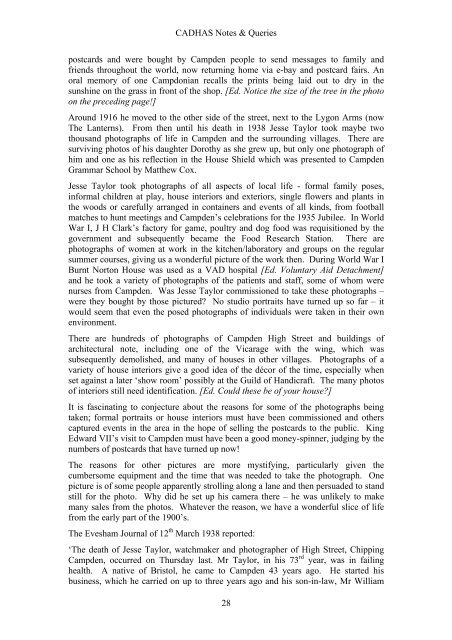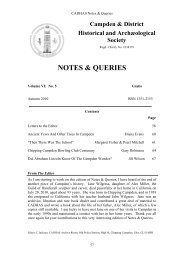notes & queries - Campden & District Historical and Archaeological ...
notes & queries - Campden & District Historical and Archaeological ...
notes & queries - Campden & District Historical and Archaeological ...
You also want an ePaper? Increase the reach of your titles
YUMPU automatically turns print PDFs into web optimized ePapers that Google loves.
CADHAS Notes & Queries<br />
postcards <strong>and</strong> were bought by <strong>Campden</strong> people to send messages to family <strong>and</strong><br />
friends throughout the world, now returning home via e-bay <strong>and</strong> postcard fairs. An<br />
oral memory of one Campdonian recalls the prints being laid out to dry in the<br />
sunshine on the grass in front of the shop. [Ed. Notice the size of the tree in the photo<br />
on the preceding page!]<br />
Around 1916 he moved to the other side of the street, next to the Lygon Arms (now<br />
The Lanterns). From then until his death in 1938 Jesse Taylor took maybe two<br />
thous<strong>and</strong> photographs of life in <strong>Campden</strong> <strong>and</strong> the surrounding villages. There are<br />
surviving photos of his daughter Dorothy as she grew up, but only one photograph of<br />
him <strong>and</strong> one as his reflection in the House Shield which was presented to <strong>Campden</strong><br />
Grammar School by Matthew Cox.<br />
Jesse Taylor took photographs of all aspects of local life - formal family poses,<br />
informal children at play, house interiors <strong>and</strong> exteriors, single flowers <strong>and</strong> plants in<br />
the woods or carefully arranged in containers <strong>and</strong> events of all kinds, from football<br />
matches to hunt meetings <strong>and</strong> <strong>Campden</strong>’s celebrations for the 1935 Jubilee. In World<br />
War I, J H Clark’s factory for game, poultry <strong>and</strong> dog food was requisitioned by the<br />
government <strong>and</strong> subsequently became the Food Research Station. There are<br />
photographs of women at work in the kitchen/laboratory <strong>and</strong> groups on the regular<br />
summer courses, giving us a wonderful picture of the work then. During World War I<br />
Burnt Norton House was used as a VAD hospital [Ed. Voluntary Aid Detachment]<br />
<strong>and</strong> he took a variety of photographs of the patients <strong>and</strong> staff, some of whom were<br />
nurses from <strong>Campden</strong>. Was Jesse Taylor commissioned to take these photographs –<br />
were they bought by those pictured? No studio portraits have turned up so far – it<br />
would seem that even the posed photographs of individuals were taken in their own<br />
environment.<br />
There are hundreds of photographs of <strong>Campden</strong> High Street <strong>and</strong> buildings of<br />
architectural note, including one of the Vicarage with the wing, which was<br />
subsequently demolished, <strong>and</strong> many of houses in other villages. Photographs of a<br />
variety of house interiors give a good idea of the décor of the time, especially when<br />
set against a later ‘show room’ possibly at the Guild of H<strong>and</strong>icraft. The many photos<br />
of interiors still need identification. [Ed. Could these be of your house?]<br />
It is fascinating to conjecture about the reasons for some of the photographs being<br />
taken; formal portraits or house interiors must have been commissioned <strong>and</strong> others<br />
captured events in the area in the hope of selling the postcards to the public. King<br />
Edward VII’s visit to <strong>Campden</strong> must have been a good money-spinner, judging by the<br />
numbers of postcards that have turned up now!<br />
The reasons for other pictures are more mystifying, particularly given the<br />
cumbersome equipment <strong>and</strong> the time that was needed to take the photograph. One<br />
picture is of some people apparently strolling along a lane <strong>and</strong> then persuaded to st<strong>and</strong><br />
still for the photo. Why did he set up his camera there – he was unlikely to make<br />
many sales from the photos. Whatever the reason, we have a wonderful slice of life<br />
from the early part of the 1900’s.<br />
The Evesham Journal of 12 th March 1938 reported:<br />
‘The death of Jesse Taylor, watchmaker <strong>and</strong> photographer of High Street, Chipping<br />
<strong>Campden</strong>, occurred on Thursday last. Mr Taylor, in his 73 rd year, was in failing<br />
health. A native of Bristol, he came to <strong>Campden</strong> 43 years ago. He started his<br />
business, which he carried on up to three years ago <strong>and</strong> his son-in-law, Mr William<br />
28







